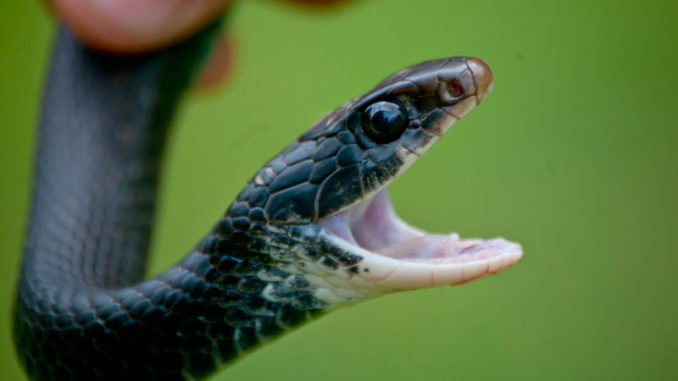
Is it venomous? Is it non-venomous? Are you still not sure? Let’s spend a little more time discussing some of the snakes you may see in and around where you live, hunt or fish. Louisiana is home to 48 species of snakes in Louisiana, only seven of them venomous.
Let’s focus on some of the non-venomous species you may encounter.
Because they have no venom on which to rely, these species use different methods to subdue their prey. Constrictors bite and wrap their prey with their bodies, squeezing tighter and tighter until blood flow is cut off to the brain and they can no longer feel a heartbeat. Other snakes overpower their prey and quickly swallow them alive.
Snakes have nostrils to breathe, but they aren’t used to smell prey as most people assume. So how do they hunt? They actually smell with their tongue. Snakes use a special organ called the Jacobson’s organ to sense chemicals in the environment. It is a patch of sensory cells in the main nasal passage that detects heavy, moisture-borne odor particles. As the snake flicks its moist tongue in and out, it collects odor particles and small organisms from whatever it touches and from the air around it, carries them back into the mouth, then presses the tongue against this organ in the roof of its mouth. A nerve connects the Jacobson’s organ to its brain, which tells it what it is smelling.
Why snakes are important
Snakes are natural predators, so killing them will only increase an area’s pest population. Venomous and nonvenomous snakes eat countless disease-carrying rodents each day, and those rodents are often covered in disease-carrying fleas and ticks that spread diseases to humans, pets, deer, squirrels, other wild game animals and even farm animals. Snakes will also eat sick and injured animals, keeping them from dying and contaminating water sources. The bottom line is, if you like to hunt and fish, you should want to see snakes to know that they are there to help keep your area healthy.

Dekay’s Brownsnake (Storeria dekayi)
One of the most-commonly encountered snakes in Louisiana is also one of the smallest. Found across nearly the entire state, these tiny snakes are typically a grey-brown color, but sometimes deep reddish-brown, with alternating rows of dark spots along the back. They have incredibly tiny heads that are often slightly darker than their bodies. Adults typically measure about 12 inches long, with the record being slightly more than 20 inches. They consume common pests like snails and slugs, so they are often found by people who are working in their flower beds and gardens. They’re very beneficial and should always be left alone to do their work keeping pests in control. Commonly misidentified as “ground rattlers,” these snakes will often vibrate their tails on leaves to mimic the sound of a rattlesnake, but they are completely harmless to humans and pets.
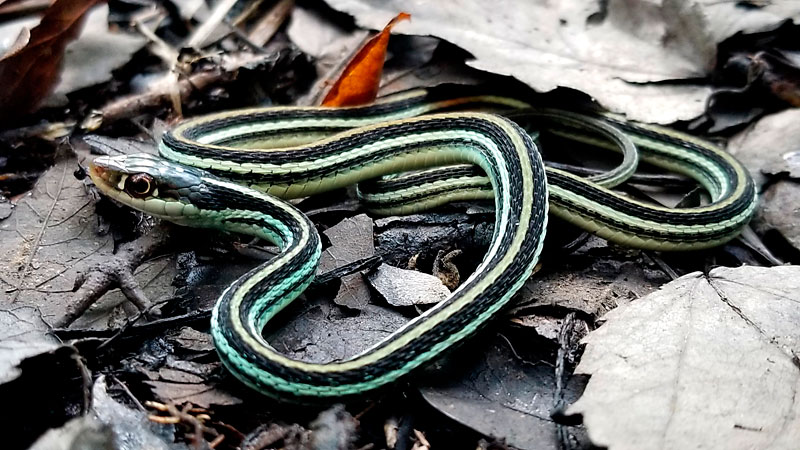
Western Ribbon snake (Thamnophis proximus)
Two of the six subspecies of western ribbon snakes (gulf coast and orange-stripe) can be found in nearly all of Louisiana. Ribbon snakes are relatively thin, quick snakes that have three cream/white or sometimes light green stripes that run the length of their bodies. Often confused with garter snakes, which are in the same genus, ribbon snakes’ side stripes are located on the third and fourth row of scales on each side of their body. They typically have a distinct white spot in front of their eyes and also lack the dark vertical lines along the side of their mouths that garter snakes have. Most of their lives are spent near water because their diet consists of minnows, fish, tadpoles and small insects. Ribbon snakes eat their prey live. Adults typically average 2 to 3 feet long, with a record length of nearly 50 inches. These snakes are very common and are easy to identify as nonvenomous since they look nothing like any of our venomous species.

Eastern Garter snake (Thamnophis sirtalis)
Of the many types of garter snakes found around the United States, only the Eastern garter snake resides in Louisiana. These small to medium-sized snakes found nearly statewide, except for the southwest portion, are cousins to ribbon snakes but are typically thicker, with larger heads. They have three pronounced stripes that run the length of their bodies that are typically white, yellow or orange and are found on the second and third row of scales. Adults average 11/2 to 2 feet long with a record of 54 inches. Like most non-venomous snakes, they will flatten their head into a diamond shape when threatened, as the one pictured has done. As live-prey eaters, garter snakes use their camouflage to blend into their surroundings and catch frogs, toads, tadpoles, fish, small birds and rodents. While extremely rare, some bites can cause a mild allergic reaction to the skin from their saliva. Unlike ribbon snakes, garter snakes typically have the dark vertical lines along the side of their mouths. Although differentiating between a ribbon snake and garter snake can be difficult at times, they are easily identifiable as nonvenomous.
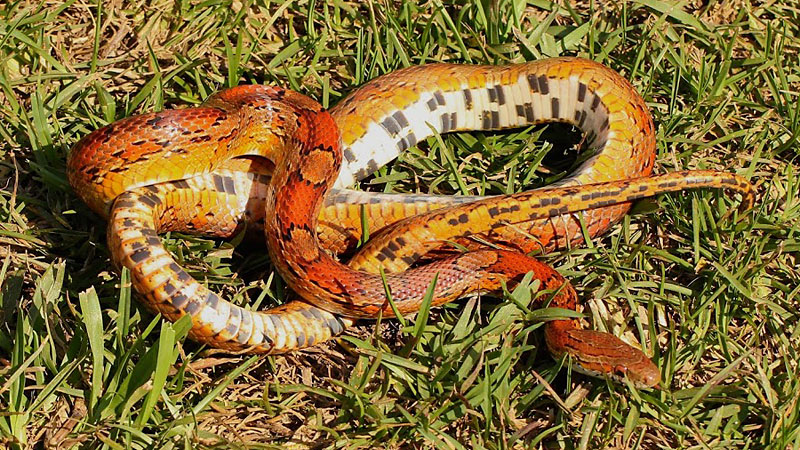
Red Corn snake (Pantherophis guttatus)
Found in the Florida parishes and between the Mississippi River and Atchafalaya Basin, corn snakes are cousins to rat snakes and are often called “red rat snakes.” These orange/red-orange snakes with darker colored blotches are often confused with copperheads because of their “copper” color, but actually look very little like the venomous species. They typically have a distinct black and white “checkerboard” belly that is visible when they are in their defensive posture. Averaging 3 to 4 feet long, with a record of 72 inches, these snakes are great climbers and constrict their prey before eating. Their diet consists mostly of rodents, but they will also eat small birds, eggs and amphibians. Corn snakes are very good to have around because they are frequent eaters and pose zero risk to humans or pets.
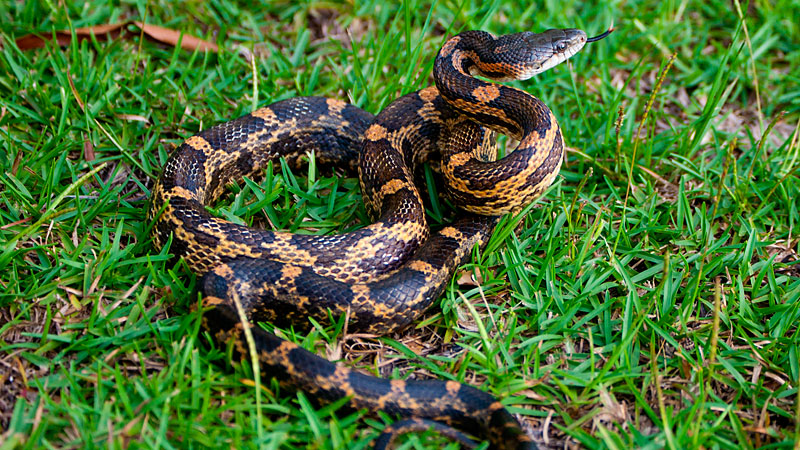
Western,Grey Rat snakes (Pantherophis obsoletus, Pantherophis spiloides)
These account for two of the 48 species in Louisiana and can be found across the entire state. The specific type of rat snake depends on their location in relation to the Mississippi river. Westerns are found West of the river, and East of the river you will find greys. Rat snakes are long and slender. They vary in color from nearly black without much of a visible pattern to pale brown, yellowish, or even orangeish with black or brown blotches. Averaging around 4 to 6 feet long with a record of 7-feet-2, these snakes can climb virtually anything including walls, poles and trees. They’re often called “chicken snakes” because they spend time around chicken coops eating mice and rats that are stealing the feed, but they’ll also eat eggs when the opportunity arises. These constrictors also eat birds and other rodents. Adults can annually consume more than 100 disease-carrying rodents, which also includes the thousands of fleas and ticks in which they are covered. Rat snakes will often display a “kinked” appearance and will coil up in a defensive posture when cornered, but they pose no danger to humans.
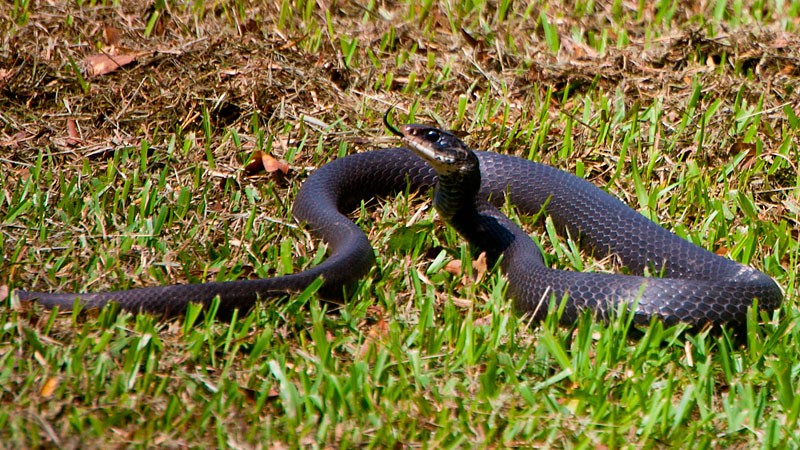
North American Racer (Coluber constrictor)
Five subspecies of the North American racer can be found in Louisiana.
- Southern Black Racer: Florida parishes; solid black with a prominent white chin.
- Black-masked Racer: Mississippi River floodplain; grey with distinct black mask just behind the eyes.
- Buttermilk Racer: Central and North Louisiana; bluish, grey or black with whitish or pale blue scales scattered on body.
- Tan Racer: few parishes in west-central Louisiana; tan/brown.
- Eastern Yellow-bellied Racer: southwest Louisiana; olive on top, fading to green with a bright yellow belly. These very fast and curious snakes, have excellent vision and are often seen “periscoping” or standing up. These constrictors eat rodents, small mammals and other snakes, including venomous ones. You’ll hear stories about people being chased by racers because they often flee in the same direction of humans while trying to get to their safe spot, which can be misinterpreted as “chasing.” Sometimes they’re incorrectly called blue racers, though that subspecies is actually found in northern states near Illinois.
Stay tuned next month for information on more of our amazing snakes. The ever popular and beloved king snakes are next! Until then, don’t forget to check out www.louisianasnakeid.com for links to their social media, contact information and for lots of snake facts and fun. They can also be found at LA Snake Boyz on YouTube.